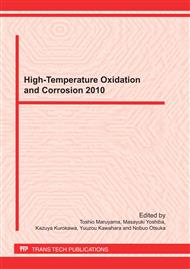p.76
p.82
p.88
p.94
p.101
p.107
p.114
p.120
p.126
Failure Characteristics of Scales Formed on Si-Containing Low Carbon Steels during Cooling - Influences of Cooling Rate and Water Vapor
Abstract:
Low carbon steels containing Si of 0.1 and 1.0 mass%, and 99.5 mass% pure Fe were oxidized in laboratory air and in a H2O-containing atmosphere at 1173 K. Acoustic emission technique was used to assess the temperature (TF) at which the first major scale failure takes place during cooling. TF of 1.0 %Si steel oxidized in the air was found to increase with an increase in the scale thickness and cooling rate, while TF of 0.1 %Si steel had almost no dependence on these parameters. Moreover, the values of TF of both the steels oxidized in the H2O-containing atmosphere are higher than those in the air. These differences are attributable to the cooling rate, scale structure, and eutectoid reaction. In general, higher cooling rate implies a higher strain rate and there may be a larger temperature gradient across the scale thickness, which additionally enhances the scale failure. The metallographic examinations revealed that eutectoid magnetite particles in the scales formed on 0.1 %Si steel coarsen as the cooling rate decreases and magnetite seam was formed at the bottom of the iron oxide layer. It is clear that the influence of magnetite precipitation increases as the cooling rate decreases and thus the stress in the scale increases.
Info:
Periodical:
Pages:
101-106
Citation:
Online since:
September 2011
Price:
Сopyright:
© 2011 Trans Tech Publications Ltd. All Rights Reserved
Share:
Citation:


